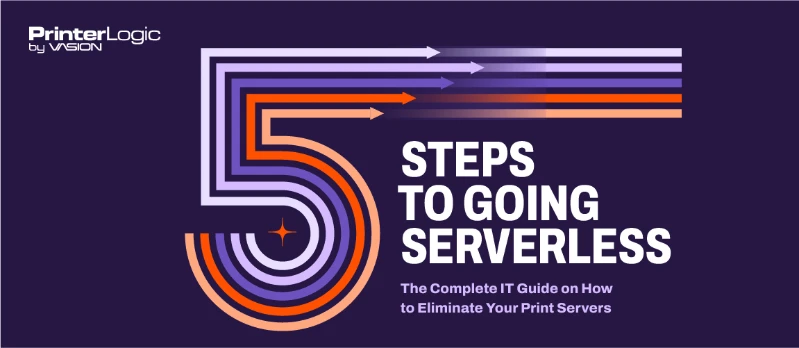Steps to Going Serverless: The Complete IT Guide to Eliminating Print Servers
Published on 17 Dec 2024

Print servers can often feel like a burden to IT departments. If you’re dreaming of a print-server-free environment, this guide breaks down how to achieve it in five straightforward steps.
Acknowledge Servers as the Problem
Understanding the root of your print management issues is crucial. Often, it's easy to blame printers, but it's actually the servers that are at fault. Here’s why:
- Single Point of Failure: When a print server crashes, all printing stops, creating a surge in helpdesk tickets.
- Decentralized Management: Adding more servers can increase speed but also requires more resources and time.
- Security Vulnerabilities: Servers are often prone to security risks, with updates and patches adding to the workload.
- High Helpdesk Demand: Issues like slow printing and installation problems lead to frequent helpdesk calls, taking up to 50% of IT’s workload.
Switching to serverless printing can address these challenges. In fact, 43% of organizations have already transitioned to cloud print management, with another 37% planning to follow within two years.
Justify the Value of Going Serverless
Eliminating print servers offers several benefits across different areas:
- Cost Savings: Reducing infrastructure cuts costs on management and licensing fees. Avoiding server vulnerabilities also helps prevent data breaches, which can be costly.
- Time Efficiency: Going serverless means no more manual security updates, fewer helpdesk calls, and quicker scaling when adding new users or printers.
- Resource Optimization: Without the need for print servers, IT teams can focus on more pressing tasks, reducing labor and training costs.
According to IBM, the average cost of a data breach in 2022 was $4.35 million globally, emphasizing the financial impact of enhanced security with serverless solutions.
Find a Solution That Meets Your Needs
When considering serverless solutions, it's essential to evaluate what your organization requires:
- Hybrid Functionality: Ensure remote and hybrid workers can print securely.
- Security Features: Solutions should integrate with your Identity Provider (IdP) to maintain Zero Trust.
- Cost Control: Look for features that allow for print monitoring and restrictions on print volume.
- Industry-Specific Compliance: Consider solutions that integrate with industry applications and ensure compliance.
- Cross-Platform Compatibility: If your organization uses multiple OSs, prioritize solutions that support various operating systems.
Ask potential vendors questions like, "Are you cloud-native?" and "What security certifications do you hold?" to ensure they’re the right fit.
Get Company Executives on the Board
Once you have identified the benefits of going serverless, present your case to upper management. Addressing their potential concerns upfront can help secure their support:
- Productivity: Cloud print management minimizes downtime, ensuring continuous print access.
- Security: Serverless solutions reduce attack surfaces, decreasing vulnerability to threats like PrintNightmare.
- Resource Management: With centralized control, fewer IT staff are required to manage printing.
- Helpdesk Reduction: Users can install printers independently, which reduces print-related helpdesk tickets by up to 95%.
Start a Free 30-Day Trial
Now that you are ready to go serverless, why not try it first? A free 30-day trial can demonstrate the benefits firsthand, allowing you to test centralized, direct IP printing and management on a single platform.
Ready to eliminate your print servers?
Download our whitepaper to learn about the complete steps for transitioning to a serverless print environment, including cost-saving strategies, enhancing security, and simplifying print management.
You May Like: Transform Your IT with Serverless Printing Infrastructure
